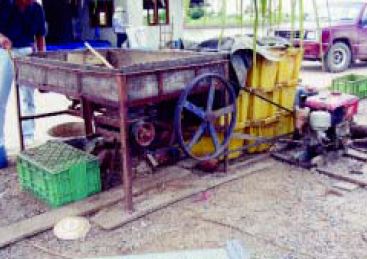9 Farm-made pond feeds
THIS ANNEX PROVIDES a very brief introduction to farm-made grow-out feeds and their use for freshwater prawns. Further reading on this topic is provided in New (1987) and New, Tacon and Csavas (1995).
1. Feed preparation
The following general instructions are for the preparation of diets, which may be fed moist or dried.
1. Mix all your dry ingredients (except vitamin mix, if used) thoroughly, preferably in a mechanical mixer.
2. Add your vitamin mix, if your formula contains one, and remix as in No. 1 above.
3. Add any liquid ingredient (such as fish oil) or any wet materials (such as chopped trash fish). [Note of caution: commercially processed shrimp by-products, such as shrimp meal and shrimp head meal, are very valuable from a nutritional point of view in feeds for freshwater prawns. There is no danger that such ingredients will cause disease problems (Flegel, 2001). However, the use of raw (unprocessed) shrimp or prawn wastes, such as prawn heads, may introduce viruses (e.g. WSSV) into your farmed animals. Although this may not cause any visible symptoms it may make them carriers of the disease for other crustaceans.]
4. Remix all your ingredients thoroughly.
5. You will now need to add up to 30-35% of water. The exact quantity depends on the moisture of the ingredients. You will need to add enough water to produce a very thick paste. Add water a little at a time and test the mixture. It is easy to add more water (but not possible to remove it if you add too much at first!). You can test the consistency (stickiness) of the diet by squeezing it within your clenched hand. If the ‘sausage’ of mixed diet (consistency of bread dough) which emerges from your fist between your first finger and your thumb is too crumbly, you need to add more water. If it runs out like a liquid, you have already added too much water!
6. Continue mixing. You can help to mix your ingredients thoroughly by passing the mixture through the coarse die of a meat mincer (see No. 7 below). This works well and also helps to bind the diet together.
7. You can now shape the mixed diet into small balls or discs by hand. However, it is best if you extrude the mixed diet through a meat mincer, this time using
ANNEX 9, Figure 1
Some farmers make their own equipment for extruding farm-made feeds (Thailand); this photo shows the tray where the mixed feed is pushed into the grinder, whose die plate is at the far side (not visible) ANNEX 9, Figure 2 In this photo, freshwater prawn feed is being extruded from the die plate of a meat chopper (Thailand)
196-1

SOURCE: HASSANAI KONGKEO
small die holes (1/8-in diameter) to produce a well-bound spaghettilike material, which breaks easily into pellets when dried. Annex 9, Figures 1 and 2 show this process.
8. You can feed your mixed diet as it is (in a moist form) if you can use it on the same day as you make it.
Alternatively, you can stir the extruded ‘spaghetti’ to form 1-2 cm long pellets and sun-dry them for later use. Drying on a concrete surface in direct sunlight for six hours (Annex 9, Figure 3) may be sufficient to reduce the moisture content of the pellets to a level (about 10-12%) at which they can be stored without excessive deterioration. Dried feed takes less space and is much easier to transport to the pond (Annex 9, Figure 4) and to feed. A simple solar dryer (Annex 9, Figure 5) can be constructed for drying pellets during the monsoon season; however, this is difficult to use if you are producing a lot of feed. Many farms find it more feasible to choose days on which the weather is forecast to be dry to manufacture and dry their feed. Others find that the feed can be collected up from the concrete drying surface if a rain cloud approaches and then put out again when the sun returns. This sounds difficult to do but the author of this manual has observed it being done! Whatever, method you choose, it is important that the feed is dried in as short a time as possible to prevent fungal growth.
9. Dried pellets can be stored up to 2-3 months. You must store them in the coolest conditions possible. It is essential to keep them dry and to protect them from rats and other animals during storage.